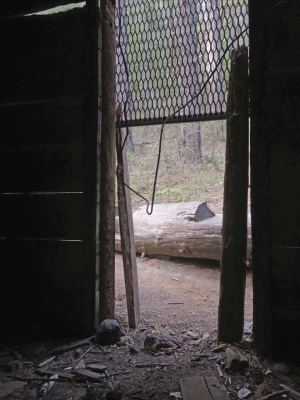Difference between revisions of "(Historic) Oregon Bigfoot Trap"
(Created page with "thumb|Bigfoot trap thumb|Bigfoot trap thumb|Bigfoot trap The trap, a 10- by 10-foot wood...") |
m (Darkwing moved page Oregon Bigfoot Trap to (Historic) Oregon Bigfoot Trap without leaving a redirect) |
(No difference)
| |
Latest revision as of 19:49, 10 April 2021
The trap, a 10- by 10-foot wooden box with a now bolted metal door, wasn’t originally a gimmick. Members of the North American Wildlife Research Team (NAWRT) built the trap in 1974, spurred on by area miner Perry Lovell, who told anyone who’d listen that he had found 18-inch long human-like tracks in his garden and had seen several large creatures roaming the area’s forests.
Lovell’s tales intrigued Roger Patterson, who had earlier stirred interest with footage of a blurry “Bigfoot” walking and looking at his camera. Patterson contacted wildlife filmmaker Ron Olson.
After visiting the Applegate region, Olson selected a trap site near Lovell’s reported sighting. After being issued a Forest Service special use permit, he and others hauled materials, including 2- by 12-foot metal planks that were bound together with metal bands and anchored to telephone poles, to the site.
It’s only about three-quarters of a mile from the roadside Collings Mountain trailhead to the trap, but before the Applegate Dam and adjoining road were built, the trap site was remote, requiring a longer, more challenging hike along a hillside above Grouse Creek.
Trapped!
Researchers hoped to lure the big-footed Sasquatch by placing rabbit, goat and other carcasses inside the trap. When entered, the heavy metal door was rigged to slam shut and sound an alarm inside a nearby watchman’s cabin. The on-duty watchman would contact the researchers, who would tranquilize, study, film and tag the creature before releasing it. Depending on the source, the only captives were a bear or two, an “angry hunter” and a hippie. In 1980, the trap door was permanently welded open.
In 2005, the abandoned trap, already seriously falling apart, was nearly destroyed by a falling pine tree. A year later, volunteers fixed the roof and replaced floorboards.
Since then, the trap has become a tourist attraction. Instead of Bigfoot, it lures hundreds of curiosity seekers, something made easy because of the proximity of the Collings trail, which leads to crumbling remains of the old watchman’s cabin. It’s a pleasant walk alongside seasonal Grouse Creek through stands of bigleaf maple, Douglas fir, madrone and, more significantly, fields thick with poison oak. Be prepared. The badly weathered trap is littered with graffiti, but it still remains a place of fascination.


